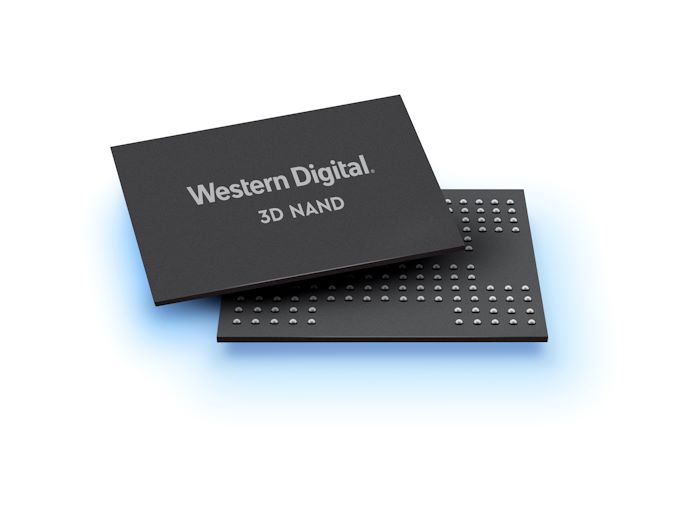Western Digital and Kioxia Announce BiCS5 112-Layer 3D NAND
by Billy Tallis on January 30, 2020 7:20 PM EST
Western Digital and Kioxia have announced the successful development of their newest generation of 3D NAND flash memory. Their fifth-generation BiCS 3D NAND has commenced production in the form of a 512 Gbit TLC part, but will not ramp up to "meaningful commercial volumes" until the second half of the year. Other parts planned for this generation include 1Tbit TLC and 1.33 Tbit QLC dies.
The BiCS5 design uses 112 layers compared to 96 for BiCS4. BiCS5 is the second generation from WDC/Kioxia to be constructed with string stacking, and is probably built as two stacks of about 56 active layers each. Even though 112 layers is only a ~16% increase over the previous generation, the companies are claiming a density increase of up to 40% (comparing 112L 512Gb TLC against 96L 256Gb TLC, by bits per wafer), thanks to other tweaks to the design that allow for shrinking horizontal dimensions. The density of the memory array itself is said to be about 20% higher. The memory interface speed has been increased by 50%, which should put it at 1.2GT/s, on par with most of the 96L competitors.
BiCS5 parts will begin sampling this quarter. With production ramping up in the second half of the year, SSDs and other products using BICS5 will likely hit the market around the end of 2020 at the earliest. Western Digital has previously stated that they intended for the BiCS5 transition to require lower CapEx than the 64L to 96L transition, reversing the trend of steadily more expensive generational updates. This means that the migration to 112L will probably be even slower than the last transition, and 96L BiCS4 will be a major part of their production volume for quite a while.










19 Comments
View All Comments
Rictorhell - Thursday, January 30, 2020 - link
Will this translate to higher capacity SSDs, or simply the ability to manufacture current capacity SSDs that are more energy efficient, at lower prices?ksec - Friday, January 31, 2020 - link
How long before we reach 2 TB SSD for $120?Billy Tallis - Friday, January 31, 2020 - link
Pretty unlikely to happen this year, even for QLC. NAND prices are going up, especially in the second half of the year when the shortage will be getting serious. I doubt we'll see BiCS5 or other NAND from that generation hit prices that low. Maybe the generation after that, but it's way too soon to know how the volume ramp of that generation will play out.Samus - Sunday, February 2, 2020 - link
I'm not sure, you can get 2TB for $180 now. They're crap but just a year ago that cost $300.Diogene7 - Friday, January 31, 2020 - link
@ksec : I am also eagerly waiting for 2TB very low power NVME SSD in BGA package for a ~120$ : it would finally make possible to have smartphone with enough storage capacity (512GB / 1TB / 2TB) to be used as a low performance computer when (ideally wirelessly like WiGig) docked with a screen / keyboard / mouse.I really liked the idea of Continuum from Microsoft, and I really, really hope Apple is working on something similar...
Unfortunately, realistically, I don’t expect this to happen before at least 2022 / 2023 for the technology and prices to make it feasible at a reasonable price, and the advent of Storage Class Memory (SCM) may even be needed to have all-in-one smartphone / computer really take off...
ksec - Friday, January 31, 2020 - link
Personally I am looking for 2TB SSD that is cheap and performance doesn't matter, it could be SATA 3 speed, so 500MB/s. Basically on one hand I want a class of SSD to absolutely push the limit of PCI-E 4.0 and 5.0, on 4 lane basis that is 8GB/s or 16GB/s. On the other hand I want an SSD that pushes capacity over everything else ( Endurance and Reliability being reasonable of coz ), and even 160MB/s I would have been fine because of the response time.But I think most NAND manufacturers know capacity is what everyone looks at, so they decide to sell us faster drive instead.
DyneCorp - Sunday, February 2, 2020 - link
Reliability? Explain what reliability is to you regarding SSDs.Soulkeeper - Monday, February 3, 2020 - link
I wonder about the heat density of this stuff. I mean look how hot HBM2 memory runs, I'm guessing we will see a lot more SSDs and flash drives failing after 1-2yrs ... or failing after being used anywhere but in an air conditioned house.Soulkeeper - Monday, February 3, 2020 - link
Those layers in the middle are bound to be well insulated. Not good.